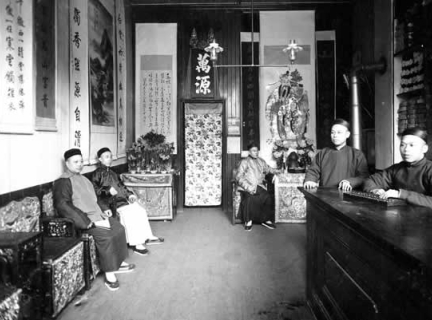Chinese Names in Canada
Image

Photo of Interior of Chinese Joss House or store, 1902. Victoria, B.C. VPL 13114
- In Canada, Chinese people sometimes followed Western custom, and changed traditional Chinese name order, placing given names before surnames. One of Yip Sang's sons became the first Chinese doctor in Canada. His name according to Chinese custom was Yip Kew Ghim, but he was also known as Kew Ghim Yip.
- Sometimes surnames became given names. This is seen in the case of the first Chinese baby born in Canada, Won Alexander Cumyow. The official registers of his marriage (1889) and death (1955) record his given names as Won Alexander and his surname as Cumyow. He appears to have been known this way throughout life. However, his original family surname was Won, not Cumyow.
- Chinese people often adopted a Western given name. For example, Won Alexander Cumyow married Ye Chan in 1889. In due course, she came to be known as Eva, the given name that appeared on her death certificate and in her obituary.
- There was no standard for expressing the characters of a person's Chinese name in the roman alphabet. Standardized romanization systems (Wade-Giles and later Pinyin, preferred today) were developed for the benefit of foreigners who could not read Chinese characters. Both Wade-Giles and Pinyin are romanizations of Mandarin, the national language of China. However, people of Chinese origin themselves had no particular need to romanize their names in a manner consistent with the Chinese characters. Moreover, most immigrants were Cantonese-speaking, and although there are some systems for romanizing Cantonese dialects, there is no standard system comparable to Wade-Giles / Pinyin.
- "Paper names" were often used. Many Chinese moved back and forth between China and Canada. In some cases, identity documents were exchanged or sold to others for the purpose of circumventing discriminatory legislation. Chinese immigrants arriving in Canada frequently identified themselves using someone else's papers.
- People sometimes took the name of their business and used it as a personal name. Chang Toy, for example, owned the Sam Kee company and was known by that name.
- Chinese names were unfamiliar to the English-speaking-and-writing clerks, registrars, and other persons who initially created official records (for example, registers of births, marriages, and deaths and census returns). Such individuals would not have understood the complexities of Chinese names and language. Even when there were translators, the rendering of Chinese names into English was often misconstrued. The prevalence of the name Ah in many references to Chinese people in original sources is a good example of how Chinese names were misinterpreted. Ah is not a Chinese name, but is a prefix added to the personal name as a familiar or informal manner of address. In the English language this is somewhat equivalent to the addition of a suffix (-ie or -y) such that Ann becomes Annie and Jim becomes Jimmy. For some Chinese people, the Ah part has been incorporated into the English versions of their surnames. For example, a person named Liu Tai Ling (i.e. surname Liu and given names Tai Ling) could commonly be called Ah Ling, resulting in the English-speaking scribe's creation of the surname Ah Ling or Ahling and the obliteration of the real surname, Liu.
- Some Chinese Canadians took the full name of their founding ancestor in Canada as their surname. For example, the children of pioneer Yip Sang for a time used Yipsang as their surname. If the person was commonly known as Ah, however (e.g. Ah Tai), and few people knew his surname, then his descendants might eventually take Ahtai as their surname.
- Name changes may also have occurred for other reasons. For example, many Chinese immigrants married First Nations women and adopted their surnames.
